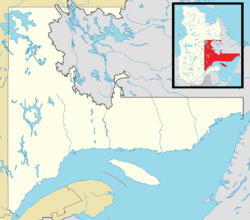La Romaine | |
|---|---|
First Nations reserve | |
 | |
| Coordinates: 50°13′N 60°40′W / 50.217°N 60.667°W | |
| Country | Canada |
| Province | Quebec |
| Region | Côte-Nord |
| Regional county | none |
| Formed | 1956 |
| Government | |
| • Chief | George Bacon |
| • Federal riding | Manicouagan |
| • Prov. riding | Duplessis |
| Area | |
| • Land | 0.88 km2 (0.34 sq mi) |
| Population (2022)[3] | |
| • Total | 1,165 |
| • Density | 1,153.6/km2 (2,988/sq mi) |
| Time zone | UTC−04:00 (AST) |
| Postal Code | G0G 1M0 |
| Area code(s) | 418 and 581 |
La Romaine, also known as Unamenshipit in Innu-aimun and designated Romaine 2,[4] is an Innu First Nations reserve in the Côte-Nord region of Quebec, Canada, at the mouth of the Olomane River on the Gulf of Saint Lawrence. It belongs to the Innu band of Unamen Shipu.[1] Being an enclave within the Municipality of Côte-Nord-du-Golfe-du-Saint-Laurent, it is geographically within Le Golfe-du-Saint-Laurent Regional County Municipality but administratively not part of it. Directly adjacent to the reserve is the community of La Romaine consisting of a small French-speaking population.
La Romaine is only accessible by boat or via the La Romaine Airport. It is serviced by a nursing station, community radio station, arena, community and recreation centre, municipal water and sewer system, fire station, and an aboriginal police force.[1]
The name La Romaine is the French adaptation of the word Ulaman. Before its spelling was standardized, the place has also been called in times past: Fort Romaine, Olomanshibu, Olomenachibou, Ulimine, Ouromane, Olomanoshibou, Olomano, Romaine, La Romaine, Grande-Romaine, Gethsémani-d'Olumen, Gethsémani, Uanaman Hipiht, Ulamen Shipit, and Ulaman Shipu. These names applied sometimes to the old post, sometimes the village or the reserve, or sometimes to the river that flows through the place. Except for Gethsémani, all these variations have the same source: Unaman Shipu, from unaman meaning "vermilion" or "red ochre", and shipu meaning "river". Deposits of this material are found on the banks of the Olomane River.[5]
- ^ a b c "Unamen Shipu First Nation". Aboriginal Community profiles. Indian and Northern Affairs Canada. Archived from the original on 2011-06-13. Retrieved 2010-10-04.
- ^ Ministère des Affaires Municipales, Régions et Occupation du territoire - Répertoire des municipalités: La Romaine
- ^ a b "Indigenous communities in Quebec". 15 October 2021.
- ^ "La Romaine, Quebec (Code 2498804) Census Profile". 2021 census. Government of Canada - Statistics Canada. Retrieved 2024-11-12.
- ^ "La Romaine (Réserve indienne)" (in French). Commission de toponymie du Québec. Retrieved 2010-10-04.
